It is not uncommon for students to show up at our courses aware they have lost several inches of height since their youth. In our culture it is a widely held expectation that you grow up, and then, at some point in later life, start getting shorter again. We all see friends, neighbors, or family members who are on the downward run of this trajectory, and it is virtually common lore that you will “shrink” or stoop in later years.

Losing height in later life is characterized as inevitable in our society. Image from Freepik
Can I expect to lose height as I age?
It is true that trauma, malnutrition, or conditions such as degenerative disc disease or osteoporosis can lead to loss of height. But our experience of working with many thousands of people over the past three decades has shown that most height loss is due to poor posture.
Let’s consider the most common reasons that people lose height:
- A tucked pelvis: The pelvis is actually in its tallest orientation when it is anteverted, which means slightly tipped forward, rather than the commonly advocated “neutral pelvis.” Pelvic anteversion is evident in our infants, our ancestors, and those living in traditional societies today, and is what we teach our students.
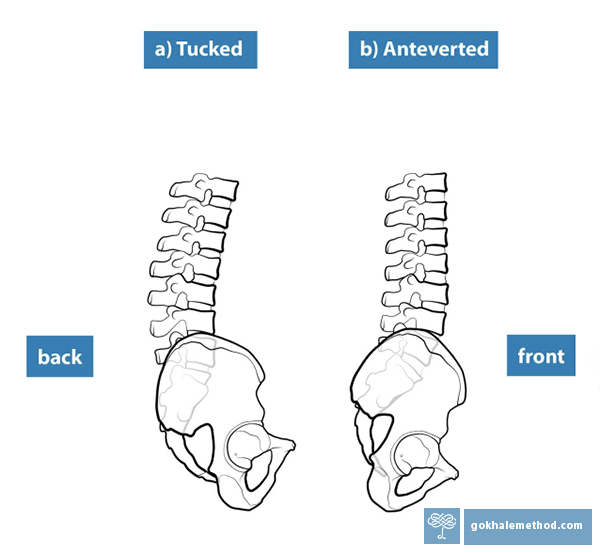
The tucked pelvis (a) is shorter and does not allow the spine to stack well on the sacrum and retain its height. More height is evident in the anteverted pelvis (b).
- Unhealthy spinal curves:
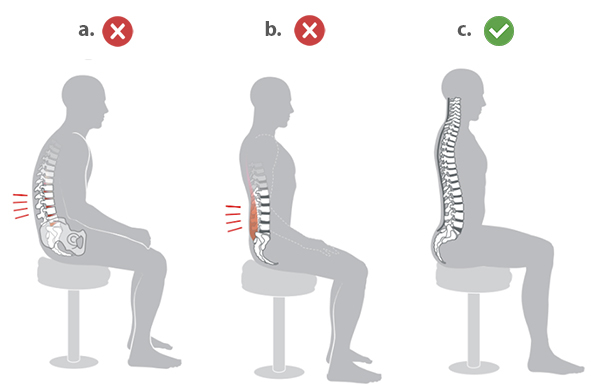
Sitting or standing with a tucked pelvis (a.), expect to see the spine adopt a compressive C-shape. This rounding of the back reduces overall height in sitting, standing, and walking. Trying to sit up or stand up straight with a tucked pelvis (b.) takes a lot of muscular tension to maintain and excessively loads the lumbar spinal joints and discs. And it also makes you shorter, not taller! A healthier arrangement (c.) allows the spine to stack in more of a J-shape, formed by a distinct L5-S1 angle, and then ascending with less curvature along the remainder of the spine. This taller spine provides space for the intervertebral joints, discs and nerves.
- A weak inner corset: Weak inner corset muscles allow undue pressure and wear and tear on the tissues, discs, nerves, and bones of the spine. This is a major cause of and contributor to degenerative spinal conditions. All can result in a visible loss of height and thickening around the waist area.
- Unhealthy bending: A lifetime of rounded bending overstretches the dorsal ligaments of the spine and produces excessive kyphosis, or rounding of the upper back—stooped posture.
- Forward head posture: A tucked pelvis and/or rounded upper back projects the neck and head forward. This brings excessive muscle tension and compression in the neck and upper back as the muscles endeavor to hold the head upright.
- Collapsed foot arches: Loss of the natural arches displace the bones and weaken the tissues of the feet, causing localized problems such as plantar fasciitis, Morton’s Neuroma, and bunions. Height and healthy function can additionally be lost through internal rotation in the knees and hips.
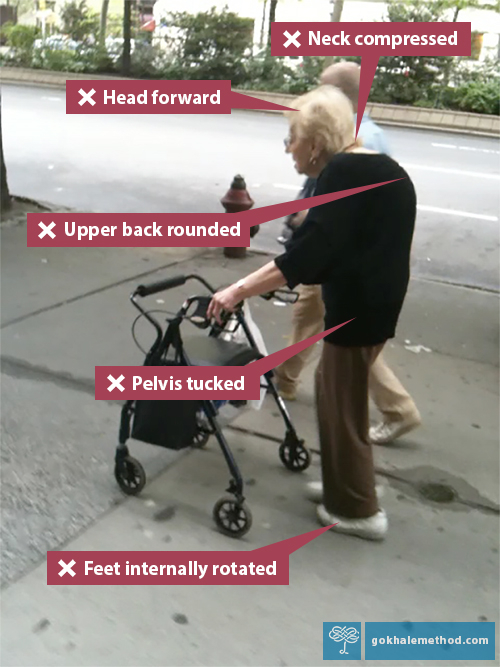
Most people in our society can expect to live into advanced years—but often with considerable physical and mobility challenges. Retaining or regaining healthy posture is key to remaining free from such disability.
Most of us are taller than we think!
It is neither inevitable nor natural to lose height as you get older. In fact, we have found that it is possible for most people, including those with degenerative conditions, to regain some height!
For a period in pre-COVID days we diligently measured the height of our students before and after they took their Gokhale Foundations Course. They averaged a height increase of two thirds of an inch (1.7 cm).
Sometimes people discover that they have stooped for years: through doing desk work in poor furniture; bending poorly; as the result of a physical or mental health crisis; or perhaps since trying to hide growth spurts in adolescence. Many of our students have a sudden awakening to the fact that they are taller than they thought. They report feeling elegant, stronger, and healthier.
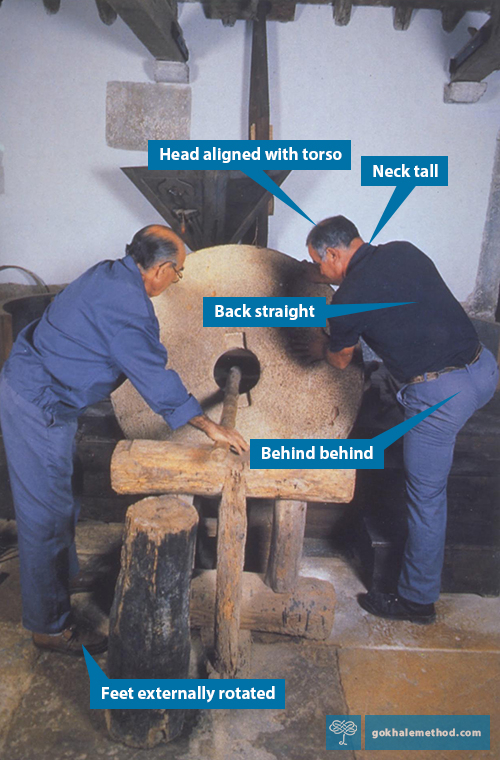
Moving like we are meant to, for example using a healthy hip-hinge like these two Portuguese workers, preserves height well into older age.
It always astonished me how students seemed more delighted to measure taller than to get out of pain! Reflecting on this, I think students have often been hopeful that their pain will resolve, but are actually surprised when they find they have recovered long-lost height. For both reasons, I share their joy!
What works to restore healthy height and posture.
Clearly, gaining height doesn't happen within a weekend course through any sort of magical “regrowth”! Nor do you get there by redoubling your efforts to “stand up straight.” But you can make transformational changes by addressing the way in which you align your feet, legs, pelvis, spine, and head. And while many of our students gain an inch or more over time, even a millimeter of regained height can be the change from impinged nerves to a pain-free existence.
Molly, a student who is nearing the end of her online Gokhale® Elements course, just wrote us:
I've been fortunate to have a very active lifestyle these 67 years. As I age, I see some effects of gravity and poor habitual posture showing up. A diagnosis of osteopenia and osteoporosis has me on alert. I was exposed to the Gokhale Method® years ago by a yoga teacher and read Esther's Book 8 Steps to a Pain-Free Back. Now, I see great results from having a one-on-one online Gokhale teacher providing additional tips, cues, and feedback. In my annual check-up last week, I had gained a half inch (1.3 cm) in height! This is great news for my spine! Thank you, Gokhale Method.
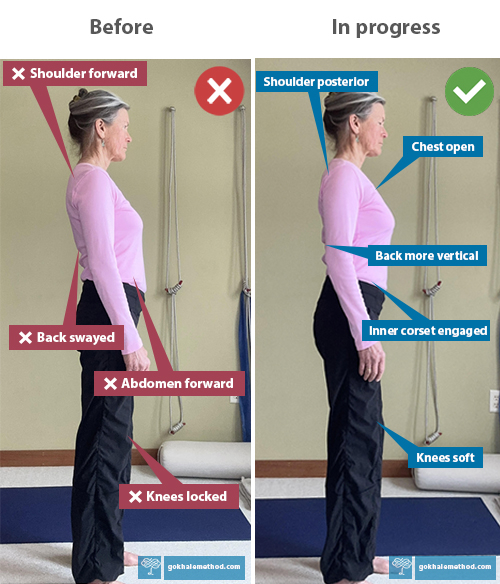
Molly used to lock out her knees and sway her back in standing (left). She is making great progress (right) as she softens her knees, aligns and lengthens her spine with a more relaxed lower back and tall neck, and rolls her shoulders back home.
My colleague Julie Johnson and I offered a special workshop called Women’s Empowerment Through Posture this week and were overwhelmed by the level of registrations and interest in this topic. Aging well without shrinking is one aspect of what we will be covering in our brand new group offering Women’s Empowerment Through Posture. Join us for six one-hour group sessions, in which we will work together to transform your posture to find a new level of confidence, relaxation, comfort, and self awareness—as well, of course, as helping with aches and pains.
Best next action steps
If you would like to know how to restore or make the most of your natural height, get started by booking a consultation, online, or in person with one of our teachers.
You can sign up below to join any one of our upcoming FREE Online Workshops…



Comments
At my last yearly physical at
At my last yearly physical at age 73, a couple years since I went through the Gokhale classes, I showed up at my doctor's office, stepped up to be measured. He stated my height aloud. All of a sudden I remembered that I needed to stand the way Esther taught me. I said, "Wait! Stop! don't write that down!" I thought through the stages I had learned, staring with the kidney bean shaped feet, the knees, the hips, the shoulders, the rib anchor, the neck. Then i said, "OK, now measure me." He was suprised to tell me I had grown 1/2 inch, taller than my 30 year old body had been when he first became my doctor. Now if I can just keep remiding myself to do this.